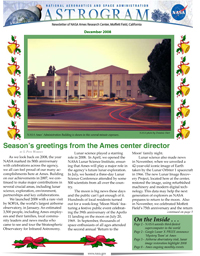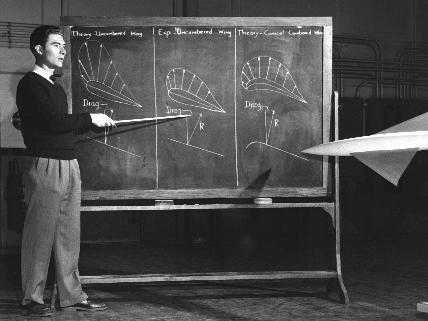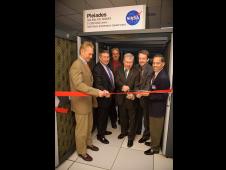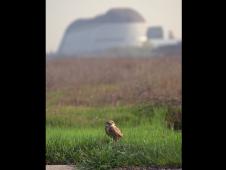Connect to NASA Ames
Ames in the News
Hangar One may house new airship (www.mv-voice.com)→
Martian methane belch: From rocks or microbes? (http://news.yahoo.com)→
Mars Methane Gas May Signal Biological Activity, Study Says (www.bloomberg.com)→
Foothill-De Anza pushes ahead with NASA project (www.mercurynews.com)→
Navy "Action Memorandum" regarding Hanger One (www.bracpmo.navy.mil)→
Read about NASA Ames in other news stories
Ames Astrogram
The NASA Ames Employee Newsletter

› View the December issue of the Astrogram
› View Archive
Featured Stories
News and Features
-

Astronauts Call Lakebay Washington Students From Space Station
01.15.09 - Reporters are invited to witness students from Key Peninsula Middle School of Lakebay, Wash., while they chat with NASA Expedition 18 astronauts Mike Fincke and Sandra Magnus, who are aboard the International Space Station on Jan 21, 2009.
-

62 Years at NASA and Still Going Strong
01.15.09 - Sixty-two years ago today, Jack Boyd, senior advisor to the Ames director, first reported to work at Moffett Field, the home of NASA's Ames Research Center.
-

NASA Astronaut Connects With Utah School From Space
01.13.09 - Media are invited to witness a chat between students from Utah's only NASA Explorer School and astronaut Sandra Magnus, who is aboard the International Space Station on Jan 15, 2009.
-

NASA to Hold Science Update about Mars Atmospheric Activity
01.12.09 - NASA Ames Research Center invites news reporters to participate in a NASA science update at 11 a.m. PST, Thursday, Jan. 15.
Ames Twitters
Center Director
-

NASA Ames Center Director
S. Pete Worden
Ames Image of the Week
Visiting Ames
-

NASA Exploration Center
Visitors are welcome to view exhibits from NASA Ames Research Center.
Let's Save Hangar One
Ames Academy
-

NASA Ames Academy →
NASA Ames Academy for Space Exploration Now Accepting Applications (Deadline 1/26/09)





